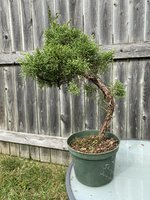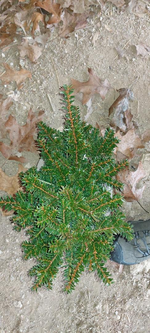Bonsai Nut
Nuttier than your average Nut
One thing that has not come up in this conversation is that there is a world of difference between bare-rooting a tree being brought in from the wild, a tree that is root-bound in a nursery pot, and a tree with nice roots already well-established in bonsai soil - even when they are the same species.
Also, in terms of half-bare root, I normally think of the rootball as a pie, and work "slices" of the pie all the way to the center. I wouldn't typically recommend the "outer half / inner half" method, since the inner half is normally where the problems are going to lie (usually the oldest soil, most compact, fewest fine roots, etc). Again, "it depends"... and is another reason why you should inspect the rootball thoroughly before you dive in and start cutting. I have had some unpleasant surprises with an initial repot, when I find roots that are extremely one-sided, or long and wrap around the base, or are otherwise messed up, when a "normal" approach would not apply. Once established in bonsai soil, those problems have typically been addressed a long time ago.
Also, in terms of half-bare root, I normally think of the rootball as a pie, and work "slices" of the pie all the way to the center. I wouldn't typically recommend the "outer half / inner half" method, since the inner half is normally where the problems are going to lie (usually the oldest soil, most compact, fewest fine roots, etc). Again, "it depends"... and is another reason why you should inspect the rootball thoroughly before you dive in and start cutting. I have had some unpleasant surprises with an initial repot, when I find roots that are extremely one-sided, or long and wrap around the base, or are otherwise messed up, when a "normal" approach would not apply. Once established in bonsai soil, those problems have typically been addressed a long time ago.









